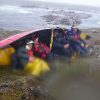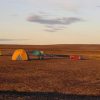Far North Canoes and Paddling Gear
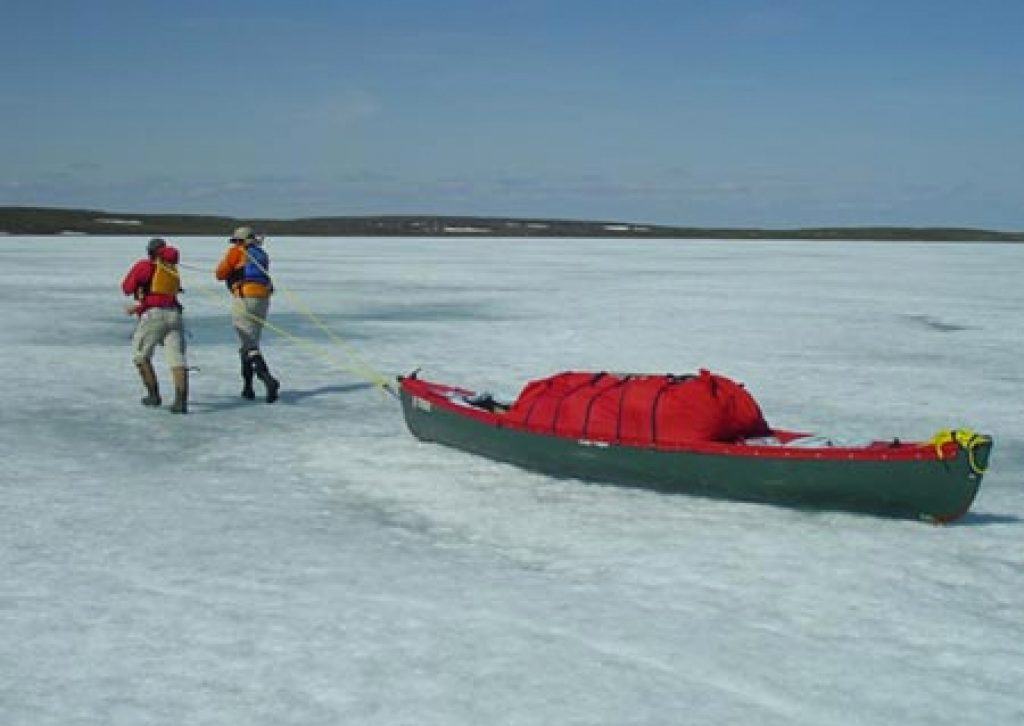
Sometimes, dragging a canoe is the only option to get it across a frozen lake.
Canoes
The most common canoes are 17-foot ABS or Royalex models. They provide enough space for gear, can be solo portaged, and fit inside twin otter planes. To many northern paddlers, including myself, the Trailhead Prospector is the definitive choice. I prefer its slightly narrower shape because it is easier to reach across the canoe when picking it up to portage. For a lighter Royalex option, consider Royalite. Not as tough, but if you do not abuse your canoes, Royalite is a viable option.
There are also cheaper plastic canoes such as the popular Old Town Discovery series. The Old Town Discovery 174 is no longer in production but they are still lots of them around. The shorter version, the 169, is still available. Also, don’t disregard other non-Royalex options such as Clipper Duraflex or Novacraft Bluesteel.
The new boat standard is folding canoes, notably Ally and PakCanoe models, because of the air regulations surrounding flying with external loads and blocking exits. I’ve been using a PakCanoe for years with great success. It paddles well, is light to carry, and fits on a wider variety of planes, including commercial flights. It expands boat pickup options as well.
If you’re using a float or wheeled charter plane, make sure your canoe can make the flight. Ask if there is an option of an external load (nested or unnested canoes) or if an internal load (stacked or nested inside, or folding canoes) is your only choice.
Outfitting Your Boat
Basic outfitting improves your safety and comfort:
- Kneepads—make kneeing a viable paddling position, which increases boat control and stability.
- Grab loops—make canoe rescue easier and aid in pulling and dragging canoes.
- Short ropes—on thwarts and the bow handle make it easy to tie-in or secure daypacks and camera boxes. I add carabiners to either the tie-in loop or my gear and clip in.
Other outfitting options worth considering:
- End air bags—increase floatation, deflect water, and the bow bag acts as a resting place for a map case.
- Thigh straps—improves your ability to control your canoe.
- Portage yoke—improves portaging safety and comfort. I install Teal yokes in my canoes.
- Painters—floating rope, three eights or half inch is easier to hold onto than quarter inch rope.
- Throw bag—attached to the stern grab loop for self-rescue.
- Bailer or hand pump—pumps work well with folding canoes because bailers catch on the stick framing. They’re also easier for covered canoes.
- Sponge—removes mud or sand from the inside of the canoe without removing the gear or spray deck. A sponge is also handy to clean out a tent as well as to bathe with. I’m a skinny guy with no body fat and the last one to go for a cold-water bath. My solution is sponge bathing.
- Spray Decks or Covers—used to fend off big lakes, rapids, rain, wind, and cold. Covers add weight but with a lack of portaging, the benefits outweigh the additional weight. (Consider options like two paddle pockets and tie down options for throw bags, painters, and map cases. Some decks have a split deck, zipper, or hatch option for accessing gear such as lunch, daypacks, rain gear, etc. The three common manufacturers are Cooke Custom Sewing, North Water Paddle Sports Equipment, and Trailhead.)
Dragging Harnesses
The tundra is often suitable for dragging canoes, which is easier than carrying. I use webbing from my pin kit, looped as a chest harness with two handles (half a foot of “plastic” pipe). This idea originates from the animal dragging harnesses that hunters used to use.
Sails and Kites
With big lakes and rivers plentiful in the far north, the use of sails or kites can mean easy miles. I’ve sailed 60 km in a day. To me it’s all about sitting back and enjoying the experience—it’s not about sailing, so I prefer a simple and easy to use sail.
Paddling Gear: PFDs, Paddles and Rescue Gear
Personal Flotation Devices (PFDs)
Most canoe trippers find front zipper PFDs easier to don on and off compared to the side zipper style, which often requires the removal of hats and glasses. For males, I recommend trying out a female PFD because the extra chest room makes for a handy hand warmer or pocket. Many of my friends and I wear the Kokatat Ms Fit Tour. Yes, we prefer the “Ms” female version.
The Kokatat Ms Fit Tour has pockets for my sunscreen, lip balm, hand lotion, and waterproof point-and-shoot camera. I add a whistle—it’s the standard safety item found on PFDs—as well as a rescue knife.
Paddles
I take two paddles: a carbon and wood bent shaft paddle because of the nature of far north canoe trips (big lakes, large volume rivers, and long trips). The wood shaft is warm and the carbon blade is lightweight.
Zaveral paddles are popular all carbon fiber bent shaft paddles. The Zaveral whitewater model is durable but I would not use it for whitewater paddling—I’ve seen them break in action. Use it for flatwater or current. For whitewater paddling, I take a more durable, good quality, whitewater straight shaft. I love paddling whitewater and rely on my whitewater paddle to get me down the river and rapids in one piece.
Whitewater Rescue and Helmets
Paddling Far North rivers means running rapids so be prepared:
- Rescue belt and towline—wearing a rescue belt means that you always have your throw bag handy. Great for scouting and setting up safety. Northwater is the go-to company for rescue products.
- Extra throw bag(s)—on large volume rivers link several throw bags together to extend your reach.
- Lining bridles—do not underestimate the efficiency of these simple but effective pieces of gear, a godsend for lining down difficult rapids or tracking up a river.
- Pin kit—(webbing, carabineers, prusiks, and pulleys) to rescue broached canoes.
When running rapids some far north paddlers wear helmets. I pack a helmet for mountain rivers with continuous whitewater, but usually paddle without thigh straps and often without a spray-deck so I don’t bring a helmet on other rivers.
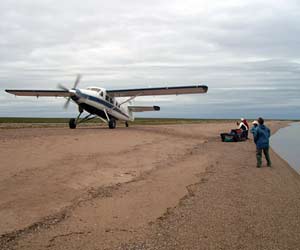
If you’re using a charter plane, make sure your canoe can make the flight. Ask if there’s an option for an external load (nested or unnested) or of an internal load (stacked or nested inside, or a folding canoe) is your only choice.
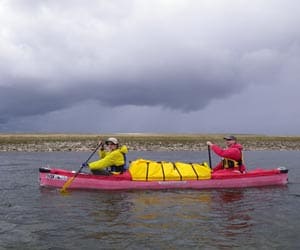
A PakCanoe with a spray deck. Spray decks help keep the canoe and gear dry on windy lakes and in rapids or rainy weather.
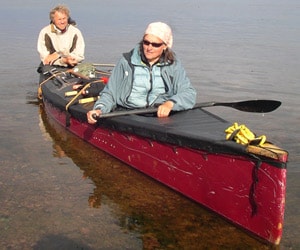
A non-ABS canoe paddled with carbon fiber, bent shaft paddles.
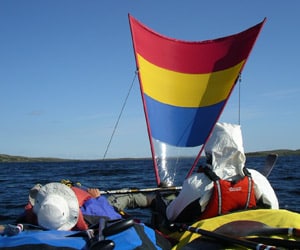
Just add wind: A sail can help Far North paddlers cover miles faster than paddling.
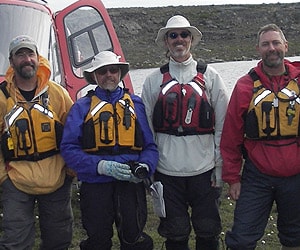
These men wear women’s PFDs because the extra chest room can come in handy as a hand warmer or pocket.
Next: Personal Gear and Clothing
 Brian Johnston, Editor of the Paddle Canada Canoe Program. Brian has paddled Far North rivers of all kinds: swift descents from the mountains into the Mackenzie Valley, subarctic rivers emptying into the Arctic Ocean, traverses from the Northwest Territories to Nunavut, and drainages into Hudson Bay.
Brian Johnston, Editor of the Paddle Canada Canoe Program. Brian has paddled Far North rivers of all kinds: swift descents from the mountains into the Mackenzie Valley, subarctic rivers emptying into the Arctic Ocean, traverses from the Northwest Territories to Nunavut, and drainages into Hudson Bay.


